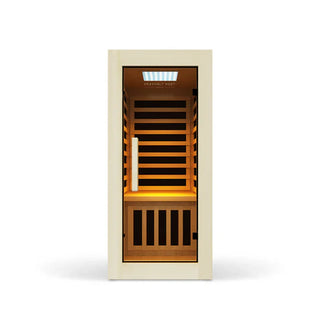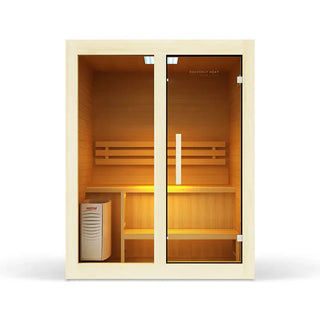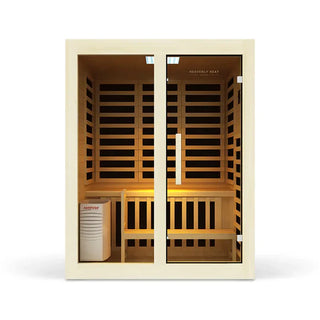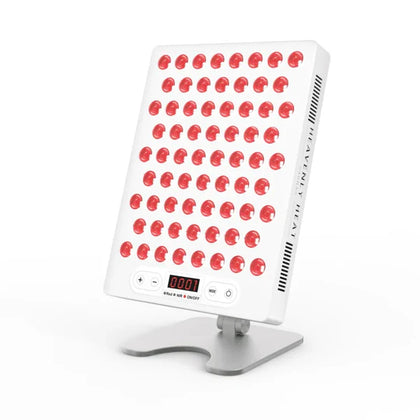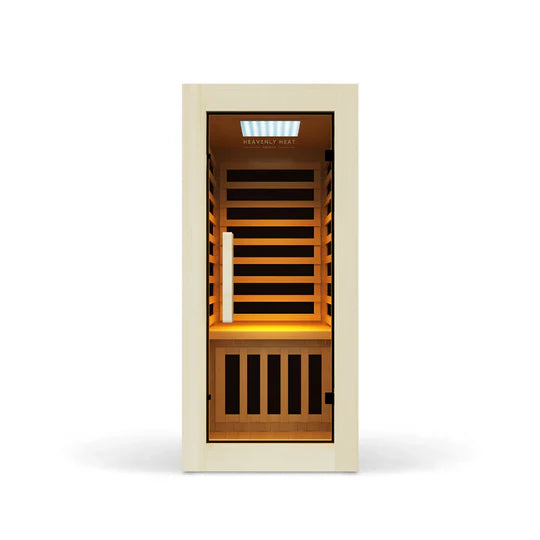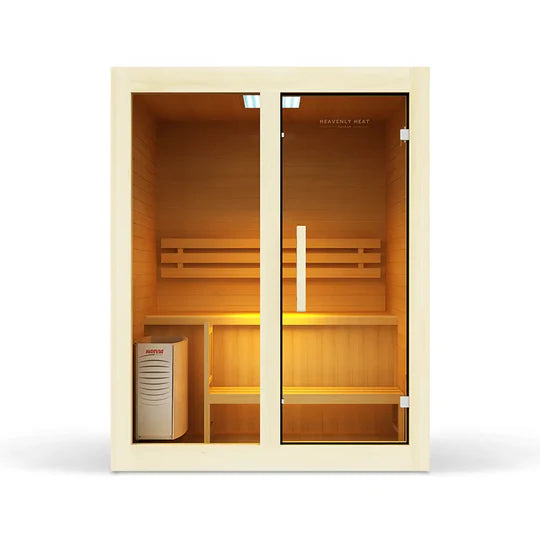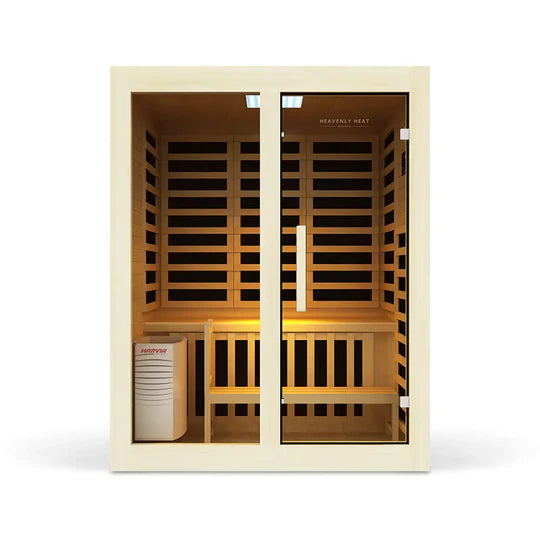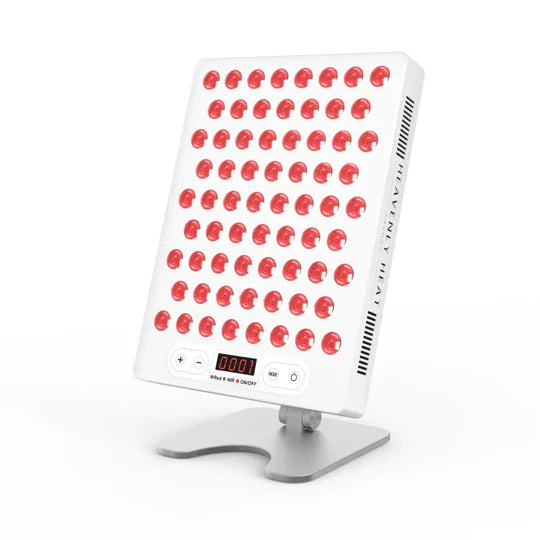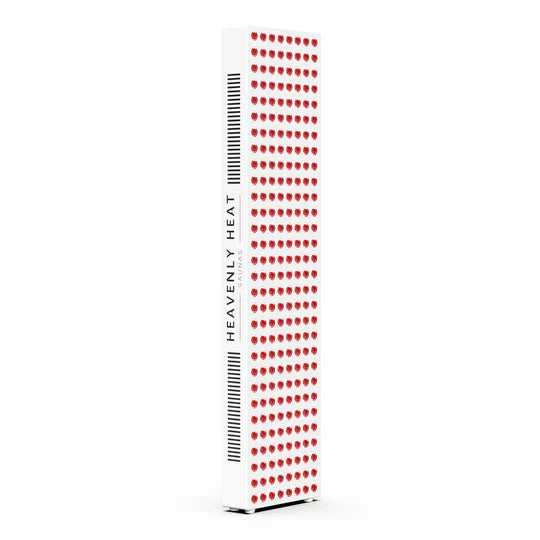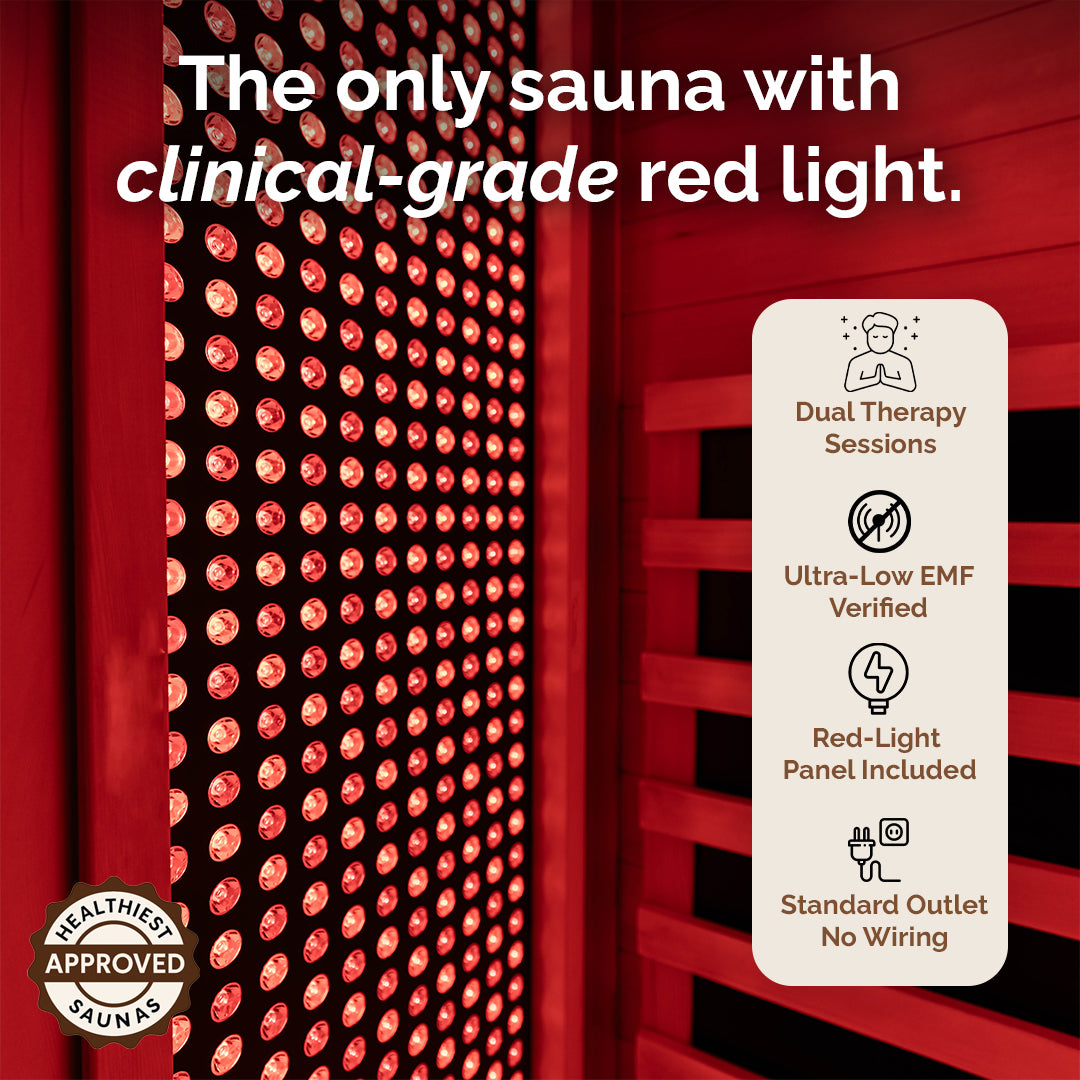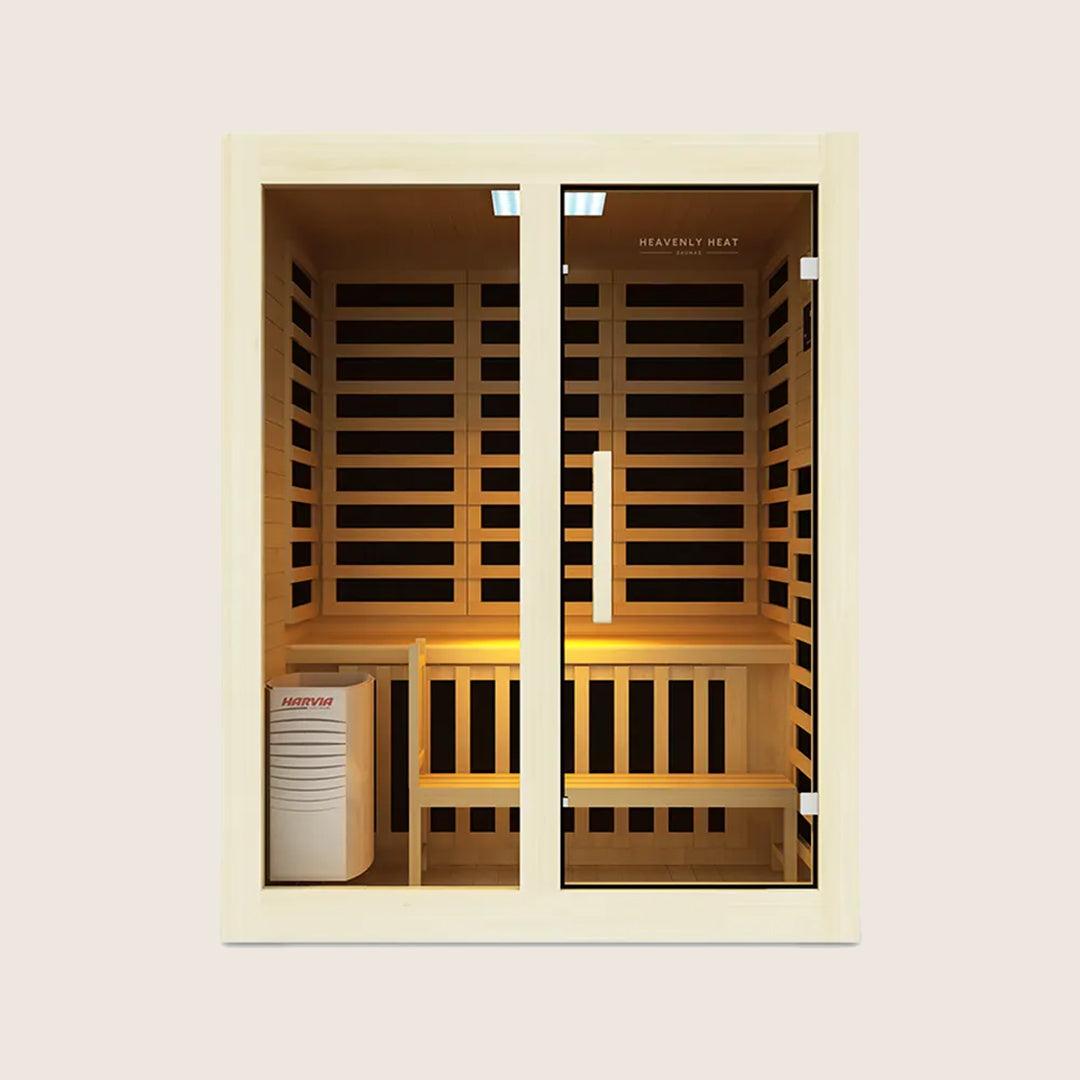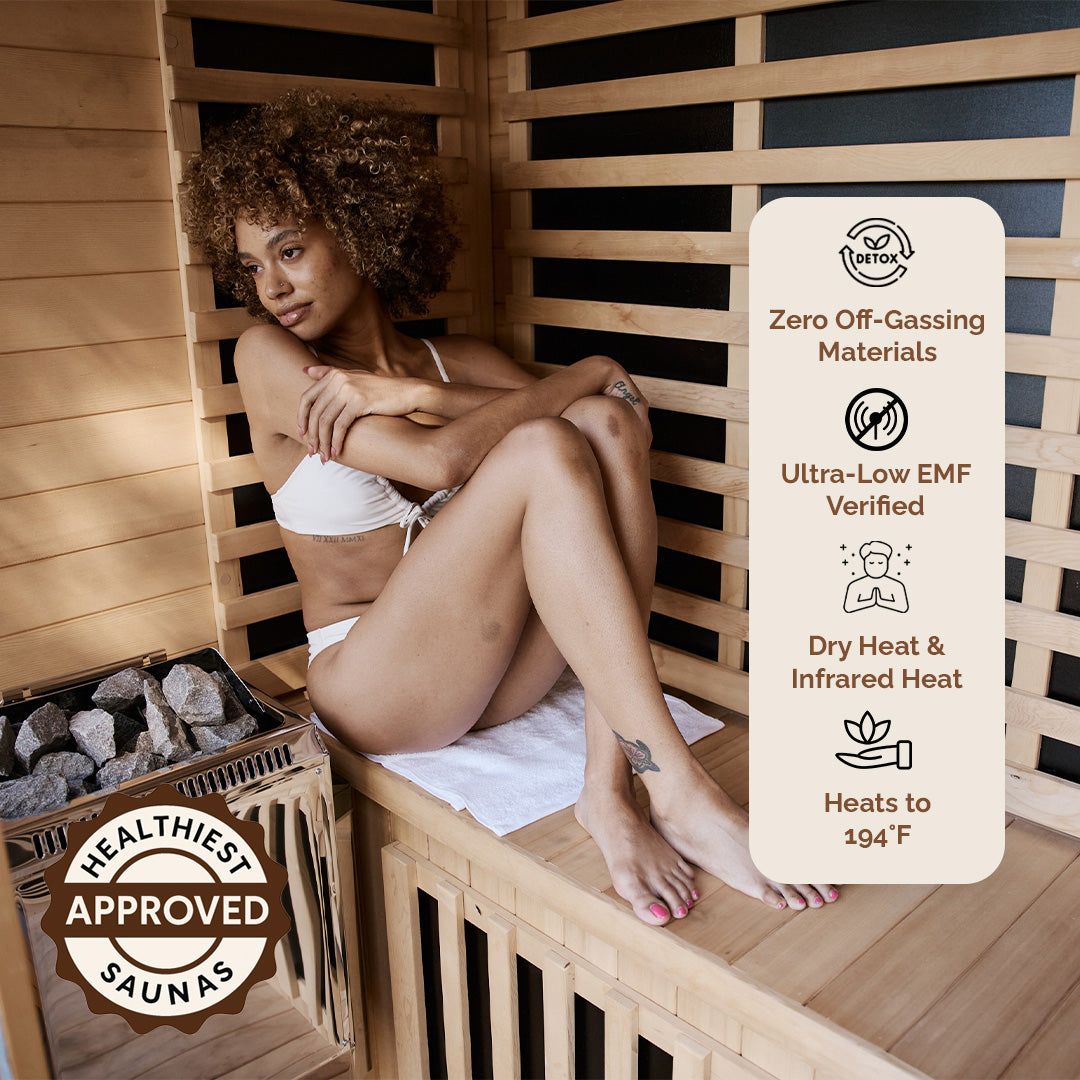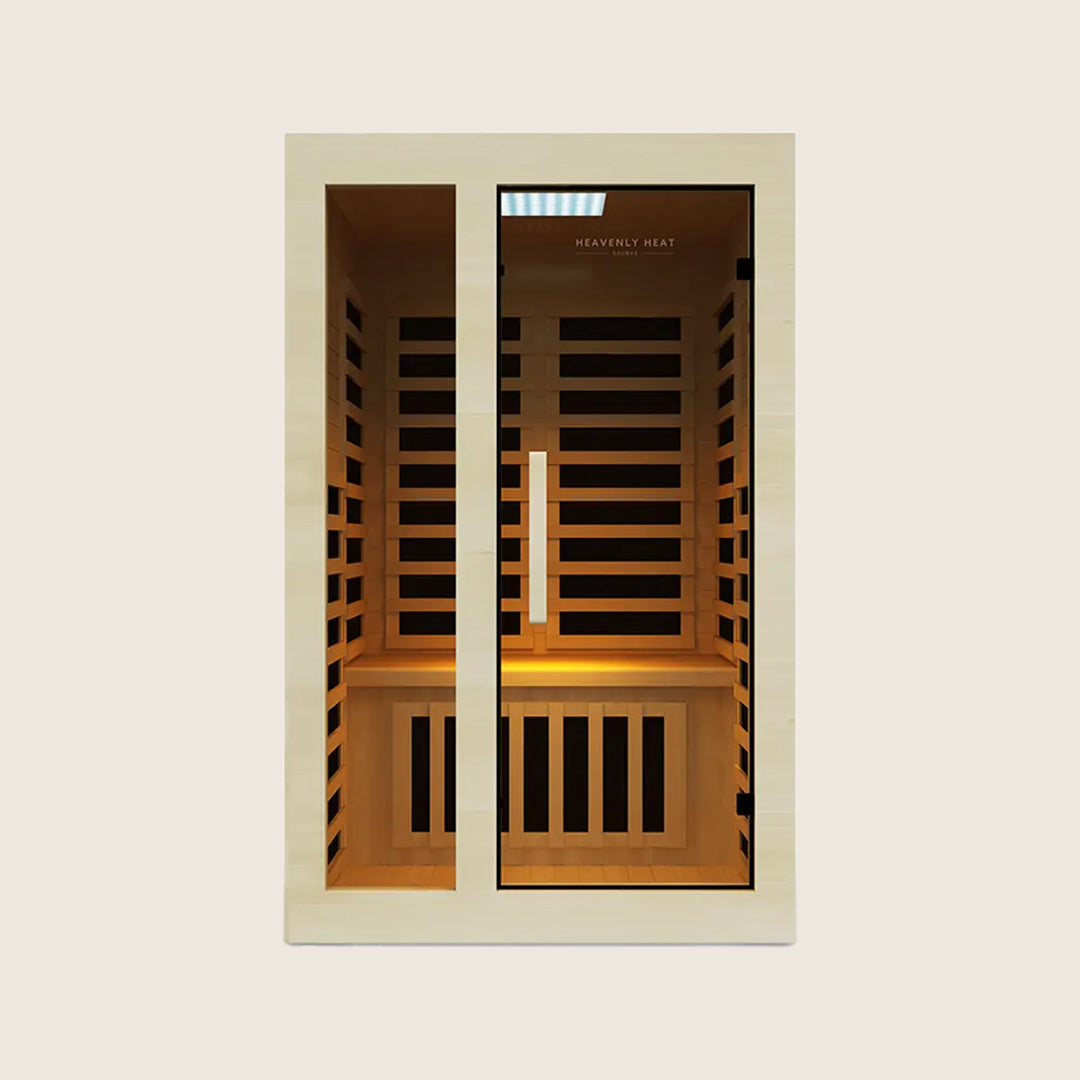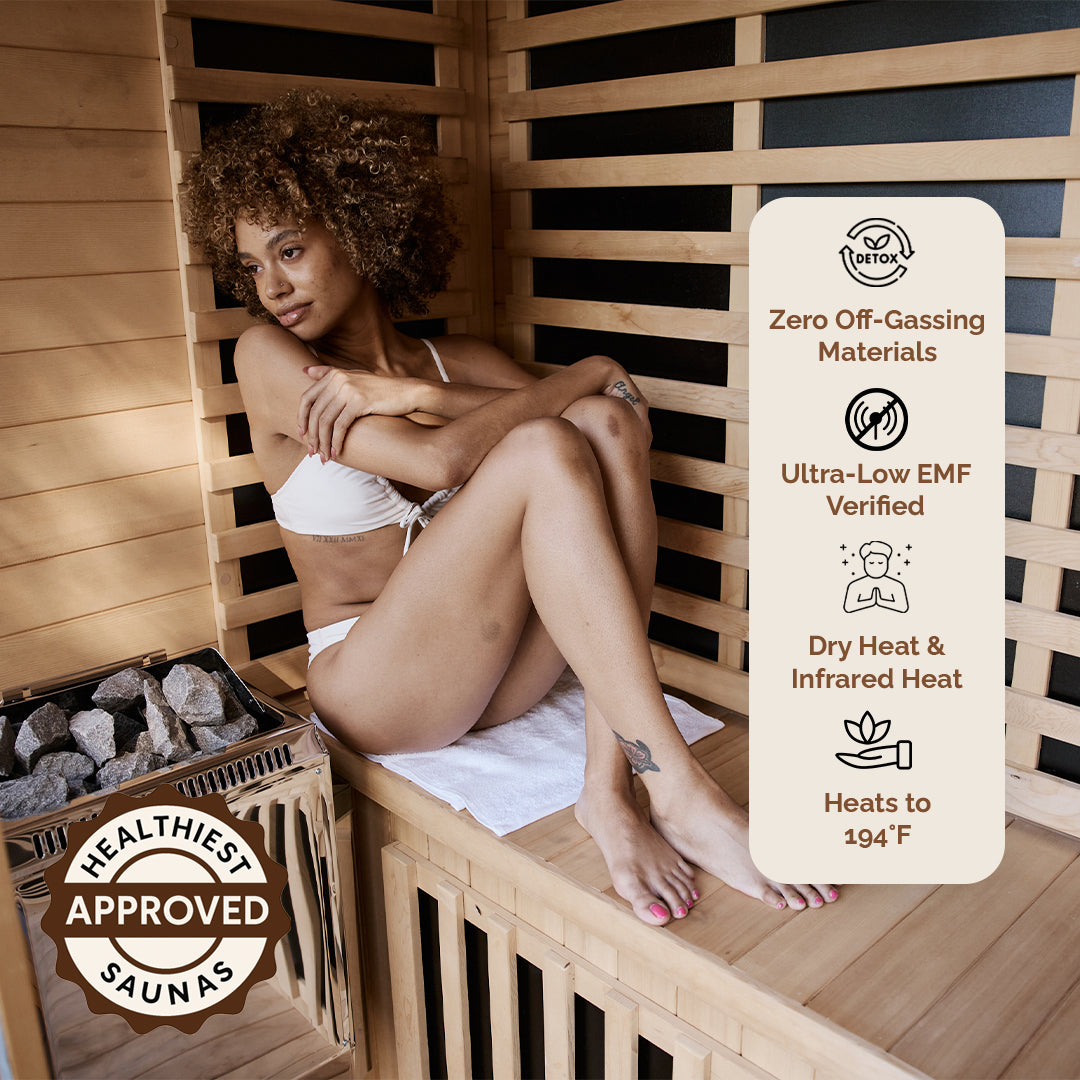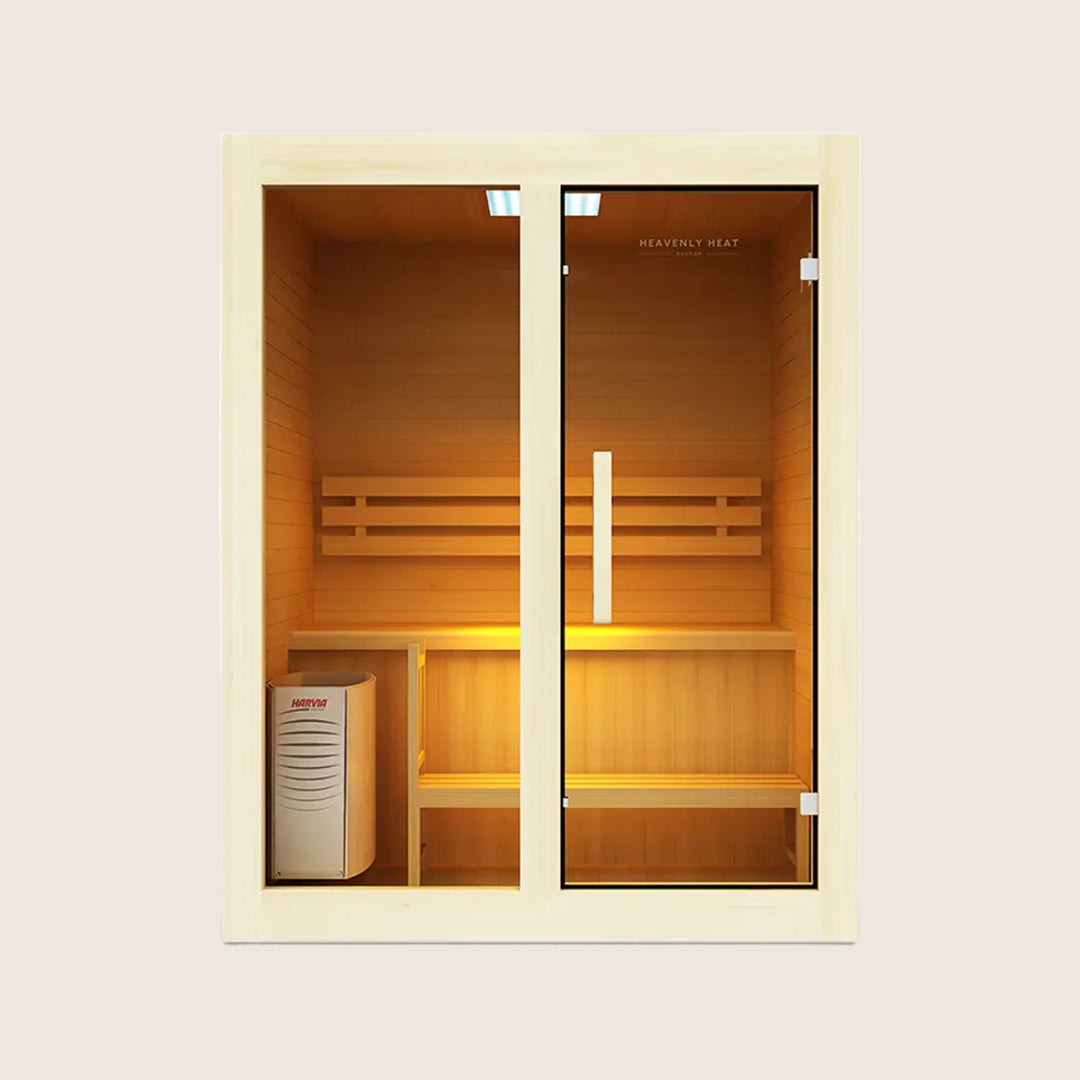What is The Difference Between Infrared Sauna And Red Light Therapy?
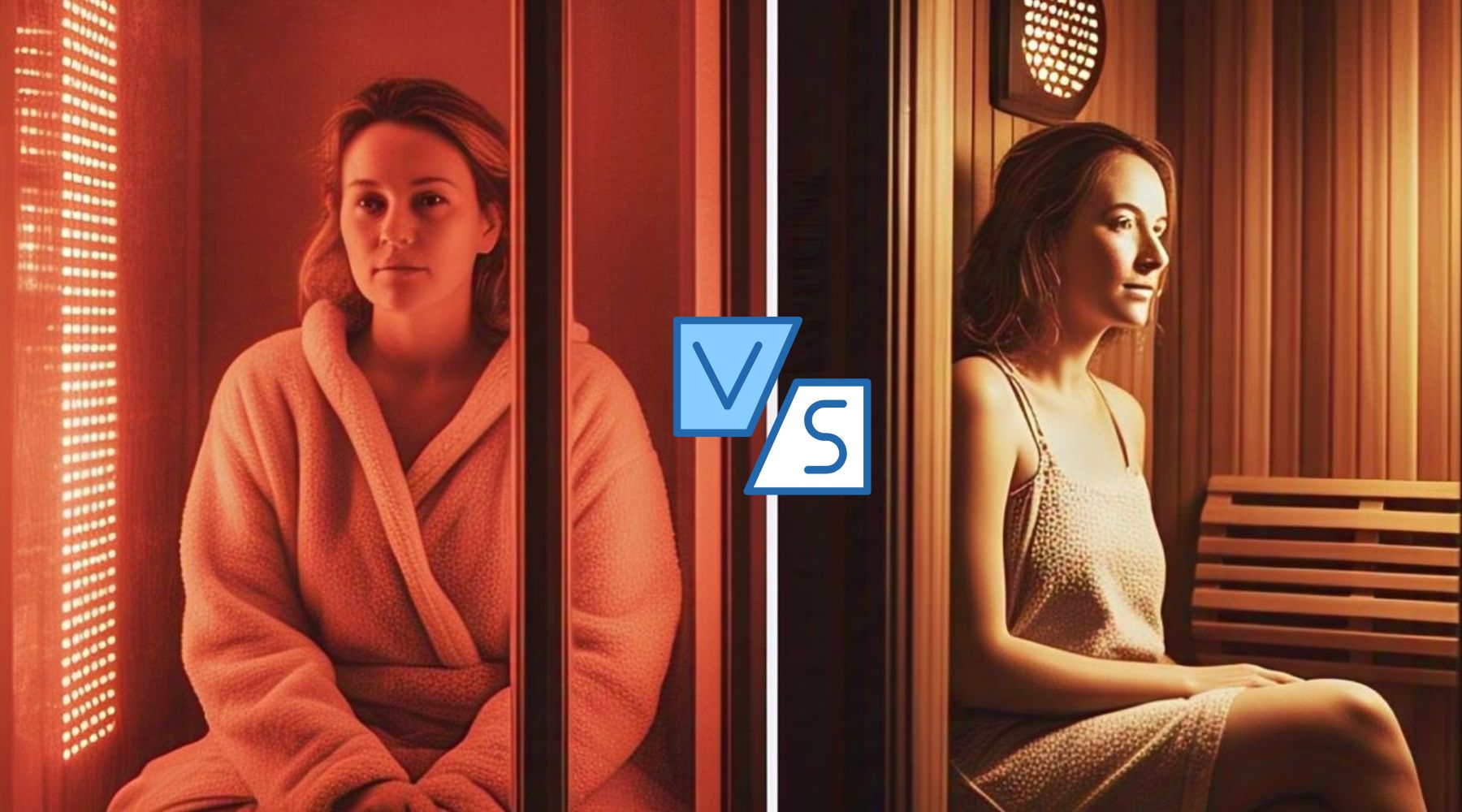
Curious about the glow of infrared saunas or the magic of red light therapy? Both offer amazing benefits like improved skin, relaxation, and recovery, but understanding the difference can be tricky.
Feeling unsure about which is right for you? Don't stress, this guide will break it all down and help you make an informed choice!
Table of contents
What Are Infrared Saunas and Red Light Therapy?
- Infrared saunas warm you from the inside without heating the air: Infrared saunas work differently from traditional ones by heating your body directly instead of the surrounding air, helping you feel relaxed faster and more comfortably.
- Red light therapy uses gentle light to help your body heal naturally: Instead of heat, red light therapy uses specific light waves to reach your cells and support healing, reduce swelling, and calm irritated areas.
Why Compare Infrared Saunas and Red Light Therapy?
- These two treatments may look similar but do very different things: Infrared saunas and red light therapy might seem alike, but they work in totally different ways. That’s why comparing them helps you choose what fits your goals better.
- One uses deep heat, the other uses healing light: Infrared saunas use strong heat to warm you from the inside, while red light therapy uses gentle light that works on your skin and cells.
- The type of light they use makes all the difference: Red light therapy works with visible red and near-infrared light, while infrared saunas use a wider light spectrum that goes deeper into your body with heat.
- You won’t get the same benefits from both: Since they do different things, they bring different results. One isn’t better than the other, it just depends on what your body needs.
- Using both together can give you better results: Want the benefits of both? You can safely combine red light therapy and infrared saunas in your routine for a more complete wellness boost.
Infrared Light vs. Red Light: What’s the Difference?
Infrared Light Is Invisible to the Human Eye, While Red Light Is Visible
- We Can See Red Light, But Not Infrared Light: Red light is visible because it falls within the range that human eyes can detect. Infrared light is outside that range, so even though it's there, we just can't see it.
- Infrared Light Goes Deeper Into the Body and Feels Warm: Infrared light has a longer wavelength, which means it can go deeper into the skin and body tissues. That’s why we often feel its warmth, even though we don’t see it.
- Red Light Doesn’t Feel Hot, But It Still Affects the Body: Red light doesn’t produce much heat, but it can still reach under the skin and help the body by interacting with cells in a different way than infrared light does.
- Looking at Strong Red Light Too Long Can Harm the Eyes: Even though red light is visible, staring at it for too long, especially at strong or wrong wavelengths, can cause eye strain, damage to the retina, or discomfort.
Infrared Light Penetrates Deeper into the Body Than Red Light
- Infrared Light Penetrates Deeper into the Body: With its longer wavelength, infrared light can penetrate much deeper than red light, reaching tissues beneath the skin to help with muscle soreness and joint pain.
- Infrared Light Targets Deeper Issues Beneath the Skin: Infrared light can penetrate up to two and a half inches into the body, effectively targeting deeper muscle and joint issues and providing relief from inflammation and discomfort.
- Infrared Light Provides More Significant Therapeutic Effects: Infrared light’s deeper penetration allows it to offer more significant therapeutic effects for conditions beneath the skin, compared to the surface-level benefits of red light.
Infrared Light Produces More Heat Compared to Red Light
- Infrared Light Emits Noticeable Heat: Infrared light emits noticeable heat that can warm the body from within, creating a comfortable, relaxing experience.
- Infrared Heat Enhances Circulation and Relaxes Muscles: The heat from infrared helps increase circulation and relaxes muscles, promoting detoxification and relaxation.
- Red Light Produces Minimal Heat: Red light produces very little heat, focusing solely on delivering light energy. This makes it ideal for treatments that don’t involve heat.
- Red Light Supports Cellular Repair Without Raising Body Temperature: Red light supports cellular repair without raising your body temperature, making it perfect for non-heating treatments.
Both Infrared and Red Light Offer Therapeutic Benefits, but in Different Ways
- Infrared and Red Light Work Differently on the Body: The purposes of infrared and red light therapy differ based on how each interacts with the body. Infrared light reaches deeper levels, while red light concentrates on surface layers. This distinction shapes how each therapy is applied and what it’s designed to support.
- Red Light Boosts Hair Growth and Revives Dormant Follicles: Red light therapy has also been clinically shown to stimulate hair follicles and promote growth in cases of pattern baldness, working at the cellular level to revive dormant follicles.
- Combining Red and Infrared Light for Pain and Skin Benefits: When used together, red and infrared light may be most effective for treating joint pain, inflammation, and skin conditions like psoriasis and acne. These differences matter because they determine how energy is used to influence various levels of the body.
Infrared and Red Light Affect Cells Differently at the Molecular Level
Both infrared and red light impact cells, but they differ in their depth and focus.
Infrared targets deeper tissues, promoting cellular activity below the surface, while red light interacts more with surface-level cells.
These differences matter because they determine how energy is used to influence various levels of the body.
Different Technologies Are Used to Generate Infrared and Red Light
- Infrared Saunas Use Heaters to Warm the Body: Infrared saunas use infrared heaters to directly warm the body, increasing heat and promoting sweating. This type of heat penetrates deeper into the body compared to traditional methods, offering more effective muscle relaxation, according to Dr. Vivian Eisenstadt, a physical therapist.
- Red Light Therapy Uses Light for Healing Without Heat: Red light therapy uses LED panels or lasers to deliver light to the body without generating heat. This therapy targets specific cells for healing, aiding in muscle recovery , pain relief, and improving skin health.
- Infrared Saunas Focus on Relaxation and Circulation: Infrared saunas are designed to help with relaxation and enhance circulation by warming the body. This creates an environment that promotes overall wellness and helps ease muscle tension.
- Red Light Therapy Targets Healing for Specific Conditions: Red light therapy is used for more focused treatments, specifically for skin issues, muscle recovery, and pain relief. It’s designed to target and heal cells, unlike the broader benefits of infrared saunas.

Health Benefits: Infrared Saunas vs. Red Light Therapy
Enhances the Body’s Natural Detoxification Process
- Detoxification Helps Your Body Get Rid of Harmful Toxins: Detoxification plays a key role in maintaining good health by helping your body remove harmful substances.
- Infrared Saunas Encourage Sweating to Remove Toxins: Infrared saunas promote sweating, which helps release toxins through your skin. Longer sessions are more effective at removing heavy metals and chemicals.
- Red Light Therapy Speeds Up Detoxification at the Cellular Level: Red light therapy improves cellular function, reduces stress, and helps your body cleanse itself faster.
- Combining Infrared Saunas and Red Light Therapy Enhances Detox: Using both therapies together supports the body’s natural detox process, leaving you feeling more energized and refreshed.
Stimulates Collagen Production for Healthier Skin
- Collagen Keeps Skin Smooth and Joints Strong: Collagen is a protein that keeps your skin smooth and your joints strong. It provides structure and support, helping skin cells grow and replacing dead skin cells. As you age, your body produces less collagen, leading to wrinkles and sagging skin.
- Red Light Therapy Stimulates Collagen for Youthful Skin: Red light therapy stimulates the cells responsible for making collagen, which results in firmer and more youthful skin. It boosts collagen and elastin production, helping the skin stay firm and elastic.
- Infrared Saunas Boost Circulation for Better Skin Health: Infrared saunas improve blood flow by expanding blood vessels and increasing circulation. This helps more oxygen and nutrients reach your skin and tissues, which are essential for collagen production.
- Regular Sauna Sessions Enhance Collagen Production: For lasting benefits, aim for 3 to 5 sauna sessions each week. The increased circulation from infrared saunas helps your body produce more collagen, leading to healthier skin and stronger joints.
Improves Blood Circulation and Oxygen Flow
- Infrared Saunas Enhance Blood Flow and Oxygen Delivery: Infrared saunas expand your blood vessels and raise your heart rate, which helps bring more oxygen to your cells.
- Red Light Therapy Widens Blood Vessels for Better Circulation: Red light therapy makes your blood vessels widen, improving the flow of oxygen and nutrients through your body.
- Better Circulation Boosts Recovery, Energy, and Skin Health: Improved circulation from both infrared saunas and red light therapy helps you recover faster, boosts energy levels, and promotes healthier skin.
Provides Effective Relief from Muscle and Joint Pain
- Infrared Saunas Provide Long-Term Relief from Muscle Pain: Infrared saunas and red light therapy both offer pain relief, but they work in different ways. A study on chronic pain patients found that those who combined far-infrared sauna therapy with multidisciplinary treatment had greater long-term improvements. Two years after treatment, 77% of these patients returned to work, compared to 50% in the non-sauna group.
- Red Light Therapy Reduces Inflammation and Eases Joint Pain: Similarly, studies show that red light therapy, or photobiomodulation (PBM), uses specific wavelengths of light to stimulate cell repair and reduce inflammation. It reduces inflammation in conditions like arthritis by triggering a cellular response rather than heating tissues.
- Real-Life Experience Shows Effectiveness of Red Light Therapy: Dr. Sarah Ballantyne shared her own experience, saying, “After consistent use, red light therapy gave me six months of relief from fibromyalgia pain.”
- Drug-Free Solutions for Chronic Pain Management: Whether through deep heat or targeted light, both therapies offer promising, drug-free options for managing chronic pain , helping people regain mobility and improve their quality of life.
Reduces Stress and Promotes Relaxation
- Stress Can Take a Toll on Your Body: Stress can take a serious toll on your body, leading to anxiety , fatigue, and even chronic illness.
- Infrared Saunas Help Lower Stress and Promote Relaxation: Infrared saunas help lower stress and promote relaxation by challenging your body with heat, which makes you better at handling stress.
- Heat Stress Builds Resilience and Reduces Stress: The heat from the sauna pushes you out of your comfort zone, building both mental and physical resilience, and helping you manage stress better.
- Infrared Saunas Calm the Nervous System: The warmth of infrared saunas helps release muscle tension and encourages deep breathing, calming your nervous system and promoting relaxation.
- Red Light Therapy Reduces Stress and Inflammation: Red light therapy reduces stress by balancing hormones and decreasing inflammation, helping your body feel more relaxed and at ease.
- Lower Stress Improves Mood and Well-Being: Reducing stress through infrared saunas and red light therapy improves mood, sleep, and overall well-being, helping you live a healthier, happier life.
Supports Deeper and More Restful Sleep
- Infrared Saunas and Red Light Therapy Improve Sleep Quality: Poor sleep can make you feel drained, affect your focus, and weaken your immune system. Both infrared saunas and red light therapy improve sleep by calming the nervous system and supporting melatonin production, which is crucial for falling asleep.
- Infrared Saunas Help You Relax for Better Sleep: The deep relaxation from an infrared sauna session helps release tension, making it easier to fall asleep. Using an infrared sauna in the evening or at night can enhance this effect, allowing you to unwind and prepare for a deeper, more restful sleep.
- Red Light Therapy Enhances Sleep Patterns: Red light therapy helps balance the body’s internal clock, improving your sleep patterns and encouraging deeper rest. A 2012 study even showed that red light therapy significantly improved sleep quality and melatonin levels, which can help you sleep better.
- Better Sleep Means Better Overall Health: Improved sleep means more energy, a better mood, and better overall health. Adding infrared saunas and red light therapy to your nighttime routine can help you get the rest you need for a healthier life.
Aids in Healthy Weight Management
- Infrared Saunas Help Burn Calories and Support Weight Management: Infrared saunas promote sweating and may temporarily boost calorie burn by increasing your heart rate, mimicking light exercise. You can burn around 400–600 calories in just 30 minutes , according to a 2017 article. While it’s not a direct fat-burning solution, it helps in supporting weight management.
- Red Light Therapy Tightens Skin During Weight Loss: Red light therapy helps tighten and rejuvenate skin areas that may be affected by weight loss. While it doesn't directly lead to fat loss, it supports the health and appearance of your skin during your weight management journey.
- Both Therapies Complement a Healthy Lifestyle for Better Weight Loss Results: Infrared saunas and red light therapy don’t replace exercise and a balanced diet. They work best as tools to complement your weight management efforts, helping you achieve better results when combined with a healthy lifestyle.
- Use These Therapies to Enhance Your Weight Loss Journey: Use infrared saunas and red light therapy as tools to support your weight loss efforts, not shortcuts. They can enhance your journey, but lifestyle changes like regular exercise and balanced eating are essential for lasting results.
Accelerates Wound Healing and Tissue Repair
- Red Light Therapy Accelerates Wound Healing: Red light therapy promotes cell growth and reduces inflammation, helping your body heal wounds faster. NASA 's research confirmed that LED light boosts blood circulation and accelerates cell regeneration, even in space. This therapy is also effective for healing gum tissue and reducing inflammation after dental procedures.
- Infrared Saunas Speed Up Tissue Repair: Infrared saunas improve blood circulation, bringing more oxygen and nutrients to the injured area, which helps wounds, burns, and post-surgery areas heal more quickly. The heat from the sauna encourages faster tissue repair, reducing pain and speeding up recovery.
- Combined Therapies Provide Faster Recovery: When used together, red light therapy and infrared saunas enhance each other's healing effects. Red light boosts cell regeneration, while infrared saunas improve circulation. Together, they help wounds heal faster, reduce scarring, and strengthen your body for a quicker recovery.
Slows Down Visible Signs of Aging
- Using the right treatments can help slow down how fast your skin and body show age: Aging is normal, but that doesn’t mean you can’t look and feel younger for longer. Taking care of your skin, joints, and energy levels can delay the signs of getting older.
- Red light therapy helps reduce wrinkles by boosting your skin’s natural repair process: This therapy works by encouraging your body to make more collagen, the protein that keeps skin firm and smooth. It also helps your skin heal and refresh itself, which leads to fewer lines and a fresher appearance.
- Infrared saunas keep your skin glowing by improving blood flow and reducing swelling: The heat from infrared saunas helps your body move blood more effectively, bringing nutrients to your skin and flushing out waste. It also eases inflammation, which helps keep joints comfortable and skin looking healthy.
- Experts agree these treatments support younger-looking skin: Top dermatologists, like Dr. Anetta Reszko, confirm that red light and infrared therapies protect and improve skin health. Their support shows that these aren’t just trends, they actually work.
- Even celebrities trust these methods to stay youthful: Famous names like Jennifer Aniston use infrared saunas regularly to help keep their skin smooth and body energized. Their routines show how useful these therapies are for maintaining a youthful look.
- With regular use, both therapies can make you look and feel younger: When done consistently, red light therapy and infrared saunas lead to noticeable improvements: smoother skin, stronger muscles, and a healthier glow, all backed by science and used by people worldwide.
Disease Prevention: Diabetes, Heart Health, and More
- Using a sauna often can protect your heart and brain: Infrared saunas are linked to a much lower risk of serious diseases like high blood pressure, heart disease, strokes, and even memory problems like dementia.
- Better blood flow from saunas helps prevent major illnesses: Saunas improve circulation and reduce swelling in the body, which lowers the chances of developing heart or brain-related health issues .
- Sauna heat can ease breathing problems and body aches: People with lung issues like the flu or long-term pain from conditions such as arthritis and headaches often feel better after sauna sessions.
Can You Combine Infrared Saunas and Red Light Therapy?

- Combining both therapies works well if done right: Using infrared saunas and red light therapy together is completely safe and can boost your wellness when used properly.
- Some saunas are built to give you both benefits at once: Modern saunas like Heavenly Heat Sauna already include both infrared heat and red light therapy, making it easy to enjoy both in one go.
- You don’t need fancy equipment to start at home: If you’re setting this up at home, you can either use a combined sauna or use separate red light panels and portable infrared saunas, both work well.
- Doing red light first helps your body get ready: Starting with red light therapy helps prepare your body, so when you step into the sauna, the benefits go deeper and feel better.
- Drinking water and using it correctly makes a big difference: Always stay hydrated and follow the time and safety guidelines to get the most from both therapies without overdoing it.
Infrared sauna vs red light therapy: Cost Comparison
- Red light therapy is more budget-friendly: Red light therapy devices typically cost between $100 and $1,000, making them a much more affordable option compared to infrared saunas. This lower initial cost allows more people to enjoy the benefits of light therapy without a large financial commitment.
- Infrared saunas require a larger investment: Infrared saunas are significantly more expensive, with prices ranging from $3,000 to $10,000 or more depending on their size, materials, and added features like chromotherapy or sound systems. This higher cost makes infrared saunas a much bigger financial commitment.
- Red light therapy has lower maintenance costs: Red light therapy devices are easy to maintain and require minimal upkeep, reducing long-term costs. In contrast, infrared saunas may need more attention, including repairs to heating elements and electrical systems, which can increase the overall cost of ownership.

Are There Side Effects? What You Should Know
- Infrared Saunas Can Lead to Dehydration or Overheating: Infrared saunas are generally safe, but they can cause dehydration or overheating. Be sure to stay hydrated and limit sessions to under 20 minutes.
- Consult a Doctor if You Have Health Conditions Before Using a Sauna: If you're pregnant, have heart issues, or suffer from chronic illnesses, it's best to consult your doctor before using an infrared sauna.
- Red Light Therapy Can Cause Skin Irritation if Overused: Red light therapy is generally safe, but overuse can cause skin irritation. Avoid staring directly at the light to protect your eyes.
- Consult a Doctor Before Starting Red Light Therapy if You Have Sensitivities: If you have photosensitivity, skin conditions, or are pregnant, it's important to check with a doctor before starting red light therapy.
The Future of Wellness: What’s Next for Infrared Saunas and Red Light Therapy?
The future of wellness brings exciting trends for infrared saunas and red light therapy, supported by a booming global wellness economy valued at $6.3 trillion in 2023 (6.03% of global GDP).
The infrared sauna market is expected to grow at a 7.1% CAGR from 2024 to 2030, while the light therapy market is set to double from $1 billion in 2022 to $2.1 billion by 2030. Key trends include:
- Personalized treatments tailored to your body’s unique needs.
- Smart devices to track progress and provide real-time feedback.
- Portable red light tools for therapy anywhere, anytime.
- Eco-friendly designs that save energy and support sustainability.
- Virtual reality integration to create relaxing, immersive experiences.
- Wearable devices for targeted therapy on the go.
- Combination therapies like red light and sound therapy for better results.
These innovations make wellness easier, more effective, and accessible to all.
Infrared Sauna or Red Light Therapy: Which One Should You Choose?
- Infrared Sauna: Relaxation, Circulation, and Detoxification: Infrared saunas offer full-body warmth that promotes deep relaxation, improves circulation, and helps with detoxification. It’s great for relieving stress and encouraging overall wellness.
- Red Light Therapy: Skin Health and Healing: Red light therapy focuses on skin health, targeted healing, and cellular repair. It’s an effective way to improve skin appearance and accelerate recovery from injuries without adding heat.
- Switching Between Both Can Maximize Benefits: You don’t have to choose just one. Using infrared saunas and red light therapy separately can provide maximum benefits, as combining them in one session may reduce their individual effectiveness.
FAQs
How do treatment durations and frequencies compare between infrared saunas and red light therapy?
Infrared sauna sessions typically last 30 to 45 minutes, allowing your body to sweat and relax. Red light therapy sessions are shorter, around 10 to 20 minutes, depending on the treatment area. Infrared saunas are most effective when used 3 to 4 times a week, while red light therapy is ideally used 5 to 7 times a week. Both can be used daily if your body tolerates them well.
Can people with heat sensitivity or heat-related medical conditions use red light therapy instead of infrared saunas?
People with heat sensitivity or conditions like multiple sclerosis or heart issues may struggle with infrared saunas due to intense heat. Red light therapy offers a gentler alternative, as it doesn’t raise core body temperature, cause sweating, or overheating, making it safer and more comfortable. It’s a better option for those who need healing without heat.
Are there differences in how these therapies affect hydration and electrolyte balance?
Infrared saunas raise body temperature, causing sweating and fluid loss, which can affect hydration. It's important to drink water before and after sauna use. Red light therapy doesn't induce sweating or fluid loss, making it less impactful on hydration and electrolytes. Overall, infrared saunas cause more fluid loss, so hydration is crucial during and after sessions.
Do infrared saunas and red light therapy interact differently with medications or skincare products?
Infrared saunas may boost blood flow, speeding up medication absorption and intensifying effects or side effects. Consult a doctor if on heart, blood pressure medications, or have liver conditions. Red light therapy enhances skincare product absorption but may irritate products with strong acids or retinoids. It typically doesn’t interact with prescription drugs, but consult a healthcare provider for guidance.


